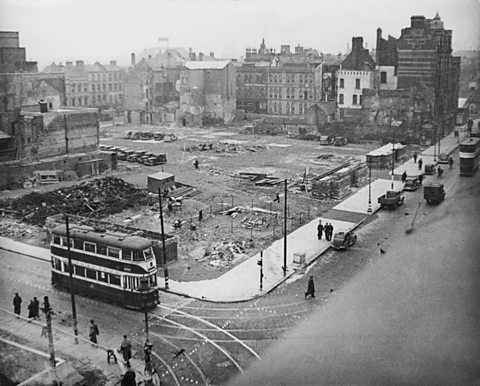The bombing of British cities â Swansea, Belfast, Glasgow
Before the war broke out, civilians had been issued with gas masks and Anderson shelters, which people were encouraged to build at the bottom of their gardens to protect them from bombs and possible chemical attacks.
Fortunately, gas was not used in the Second Word War but the shelters were very necessary. In London, after several nights of relentless bombing and lack of sleep, people took to the underground to seek safety from the attacks. In Cardiff, people used the cellars of the castle for protection.

Wartime propaganda and the press praised the spirit of the Blitz to show that the people were united, brave and would not be broken.
Bombing of cities
| City | Consequence |
| London | Bombed every night from 7 September to 2 November. 13,500 tons of high-explosive bombs were dropped in 57 raids. Over 15,000 people were killed and 250,000 made homeless. Important buildings such as St Paul's Cathedral, the House of Commons and Buckingham Palace were also bombed, and the King and Queen often visited areas that had suffered. The raids continued into 1941. |
| Coventry | Raided for the first time on 14 November 1940. In that one night, over 30,000 incendiary bombs were dropped, 554 people were killed and 50,000 houses were destroyed. |
| Swansea | Swansea was bombed on 19â21 February 1941 as the port, docks and nearby oil refinery were targeted. 230 people were killed and 397 injured. |
| Belfast | The Belfast Blitz consisted of four attacks in April and May 1941. For example, on Easter Tuesday, approximately 900 people died and 1,500 were injured. Many houses were seriously damaged and 150,000 people were made homeless. |
| Glasgow | Scotland's industrial areas were key targets of the German bombers. Glasgow had many factories and cargo ships gathered in the shipyards on the River Clyde to form convoys. When factories and shipyards were bombed during Scotland's Blitz, hundreds lost their lives and many more were left homeless by the onslaught. |
| City | London |
|---|---|
| Consequence | Bombed every night from 7 September to 2 November. 13,500 tons of high-explosive bombs were dropped in 57 raids. Over 15,000 people were killed and 250,000 made homeless. Important buildings such as St Paul's Cathedral, the House of Commons and Buckingham Palace were also bombed, and the King and Queen often visited areas that had suffered. The raids continued into 1941. |
| City | Coventry |
|---|---|
| Consequence | Raided for the first time on 14 November 1940. In that one night, over 30,000 incendiary bombs were dropped, 554 people were killed and 50,000 houses were destroyed. |
| City | Swansea |
|---|---|
| Consequence | Swansea was bombed on 19â21 February 1941 as the port, docks and nearby oil refinery were targeted. 230 people were killed and 397 injured. |
| City | Belfast |
|---|---|
| Consequence | The Belfast Blitz consisted of four attacks in April and May 1941. For example, on Easter Tuesday, approximately 900 people died and 1,500 were injured. Many houses were seriously damaged and 150,000 people were made homeless. |
| City | Glasgow |
|---|---|
| Consequence | Scotland's industrial areas were key targets of the German bombers. Glasgow had many factories and cargo ships gathered in the shipyards on the River Clyde to form convoys. When factories and shipyards were bombed during Scotland's Blitz, hundreds lost their lives and many more were left homeless by the onslaught. |
Most other major cities such as Birmingham, Bristol, Cardiff, Liverpool and Manchester also experienced bombing by the Luftwaffe.
